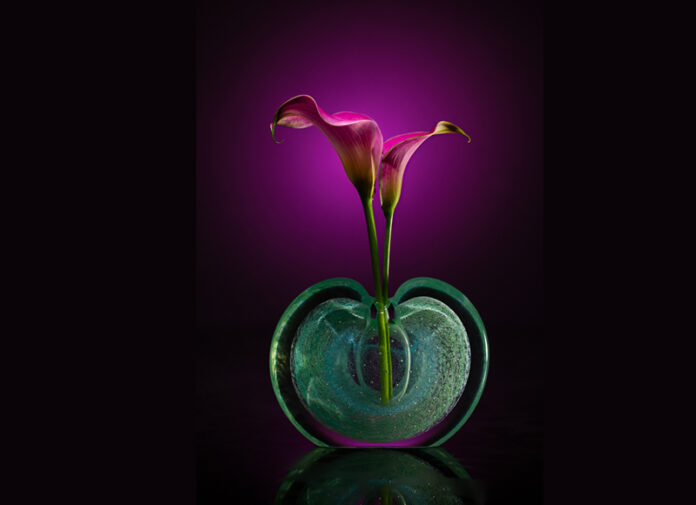by Jackie Kramer
Texas School Instructor
As life has pushed us in ways we couldn’t foresee and the ability to travel and work in close proximity to others has been severely limited due to Covid, we have been presented with new opportunities. For some, it became a perfect time to dive into floral photography; deeper for those who were already a floral fanatic and a chance to get started for those new to the genre. Accessible and affordable subjects can be purchased from local florists and grocery stores year-round or found in gardens in season. Skills employed can be applied to other subjects-macro and beyond. Still life arrangements using small subjects such as gourds, pumpkins, holiday decorations, bottles, jewelry (think wedding rings), and other trinkets can serve as terrific substitutes for flowers.
In this article, I’m going to address one of the most common questions I’m presented with which is, “What’s the best lens for floral photography?” The answer is… “It depends.” It depends on how close you are to your subject, the effect you want to achieve, whether you’re shooting on a full-frame body or not, and whether you need a macro lens or not. Let’s have a look at some examples and I’ll discuss the rationale behind my lens choice.
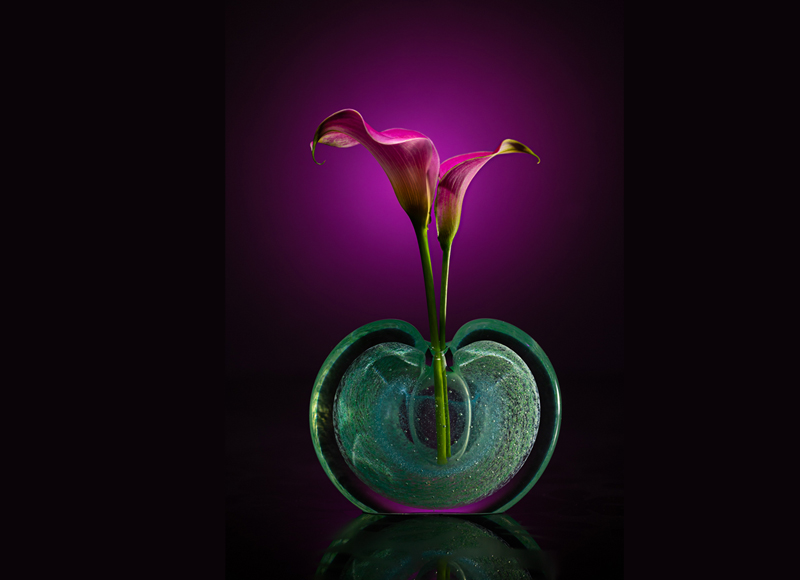 100mm macro for The Classic Macro
100mm macro for The Classic Macro
Lens: Canon EF 100mm f/2.8L Macro IS USM
I use this lens when:
• It is a sunny day outside
• I am indoors and shooting a single flower or small scene
• I want a classic macro shot
• My subject is close or fairly close
The 100mm was my first macro lens and opened up a new window into the world of flowers for me. As a general rule, I feel it’s advantageous to become familiar with a single lens before expanding one’s repertoire.
With this classic 1:1 macro, I can retain beautiful detail in my subject by shooting against a solid background, shown in the image with two Calla Lilies in a perfume bottle. Outdoors, I love to shoot wide and use selective focus to blur the background, placing a spotlight on my subject. The distance between camera to subject and subject to background are critical factors.
This is an ideal lens in harsh light when I need to shade my subject because the minimum shooting distance of 11.8 inches allows me to be close enough to my subject while holding a diffuser. I use a 20-22 inch translucent collapsible diffuser.
I should note that I’m shooting with a full-frame Canon 5D MarkIV. Remember to apply the conversion factor that correlates to your camera if it’s not full-frame.
A lens in this range (90 to 105mm or equivalent) is a great place to start if just embarking on your macro journey. Once you feel comfortable you can explore a little. A variety of gadgets can be attached to the lens, such as extension tubes, a Raynox 150 or 250 (to add magnification and drastically reduce the focusing distance), or Omni filters by Lensbaby to introduce color, flare, or other effects in the foreground or to the subject.
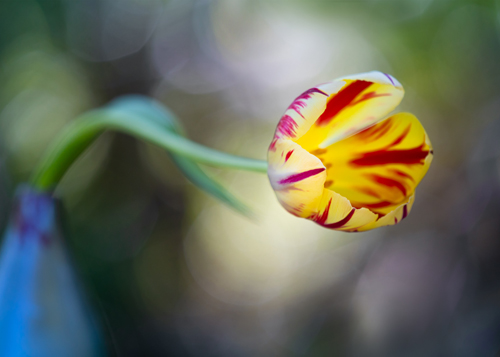 180mm macro for Dreamy Bokeh & Reach
180mm macro for Dreamy Bokeh & Reach
Lens: Canon EF 180mm f/3.5L Macro USM
I use this lens when:
• I have ideal lighting conditions outdoors, i.e. diffuse ambient light
• My subject is more than arm’s length away
• I want a classic macro shot, with creamy background
The 180mm affords me greater reach while producing both foreground and background magic. The bokeh can range from creamy to bubbly; but when fairly wide, it is all together dreamy.
I often find myself in gardens where I can’t step into the beds and my subjects are at least two to five feet away. The longer focal length is ideal in this case with a minimum focusing distance of 1.6 feet (working distance of 1.12 feet from subject to front of lens) while still at 1:1. Shooting through foliage or flowers close to the lens yields a veiled effect when shooting wide with the subject at an optimal distance from the lens, as well as from the background.
At 2.4 pounds and over 7 inches in length, this lens can be hard to hand hold. Macro lenses in the 150 to 200mm range (or equivalent) vary in terms of their heft, but all should perform similarly. There are no other macro lenses in my “bag” that reach as far, which gives me most flexibility. I can usually step back if necessary. The main drawback is that I cannot soften harsh light on subjects farther than my arm can stretch with a diffuser so I usually limit my use of this lens to overcast days or shaded areas.
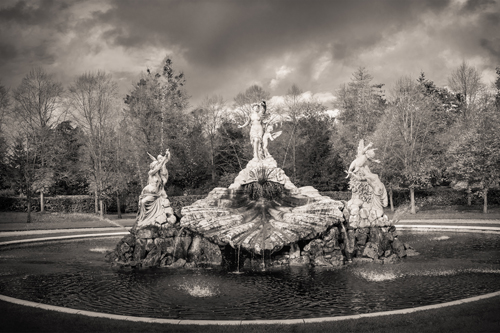 24-70mm for Environmental and Still Life
24-70mm for Environmental and Still Life
Lens: Canon EF 24-70mm f/2.8L II USM
I use this lens when:
• I’m shooting scenery outdoors
• I’m doing still life indoors & can’t capture the entire set-up with a macro
• I want flexible focal range of the zoom
While I’ve shot in some remarkable places around the world, one would never know by looking at my images, as I regrettably have a paucity of garden shots. Most of the only big picture images I leave with are on my mobile phone, and typically done as an afterthought.
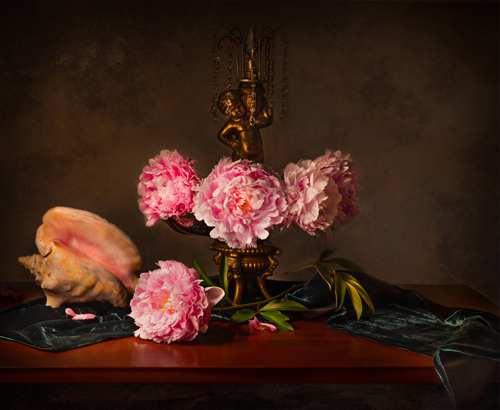 Unless I can bring a rolling bag into a garden, I am limited to what I can pack in my bag. Therefore, when I pack my weighty 1.98 lb 24-70mm, I feel an obligation to use it and, without exception, I am always grateful that I did. These are the shots which offer context and can depict the interplay between the plants in the garden, their growing habitat, relative heights, the gamut of colors, multitude of textures, and collective patterns. This is the lens that can bring home memories of garden features, such as fountains, gazebos, and sculptures.
Unless I can bring a rolling bag into a garden, I am limited to what I can pack in my bag. Therefore, when I pack my weighty 1.98 lb 24-70mm, I feel an obligation to use it and, without exception, I am always grateful that I did. These are the shots which offer context and can depict the interplay between the plants in the garden, their growing habitat, relative heights, the gamut of colors, multitude of textures, and collective patterns. This is the lens that can bring home memories of garden features, such as fountains, gazebos, and sculptures.
A wider lens also allows me to stage still life arrangements and encompass the whole scene in close quarters. With the variable focal length, I can set up my tripod and zoom accordingly.
Creativity in camera with this lens can be achieved with numerous techniques including intentional camera movement using an ND filter, multiple exposures, and zoom blurs.
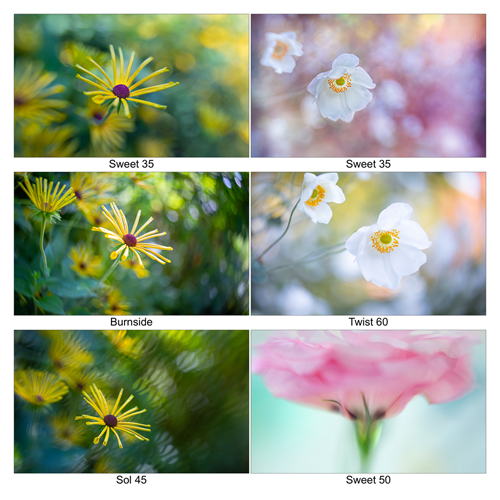 Lensbabies for Individuality & Surprise
Lensbabies for Individuality & Surprise
Favorite optics are the Sweet series (the 35, 50, and 80mm),
the Velvets (28, 56, and 85mm), the Twist 60, the Burnside 35,
and the Sol 45.
In a nutshell, I use Lensbabies when I want something totally different. It’s a welcome change after shooting thousands of flowers with my standard macro lenses using different techniques in camera and post. Lensbabies offer an element of excitement.
Investing time to understand the nuances of each optic one at a time has proven highly beneficial. For example, the Sweet 35, 50, 80mm, and the Twist 60 are all interchangeable optics which fit into a housing called the Composer Pro II (the Optic Swap System). The Composer tilts 15o pivoting around the mount. When the optic is tilted, along with it goes the “Sweet Spot” of focus, distorting the entire image as the plane of the optic departs from its parallel position to the sensor. I love the 35mm for its bokeh, especially with specular light shimmering through trees in the background; the 50mm is creamy and blends elements in a painterly way; and the Twist yields a gentle swirl effect. Macro filters and converters specifically designed by Lensbaby to fit these filter threads are handy when shooting flowers up close.
All of the others listed above are stand-alone lenses which mount directly to the camera. The Burnside 35mm adds a swirl in around the perimeter as does the Twist, but has different visual characteristics and cannot tilt. This lens is ideal with a minimum focusing distance of 6 inches and a sharp focus even when at it shallowest depth of field. It has an adjustable slider to moderate the amount of swirl or vignette effect.
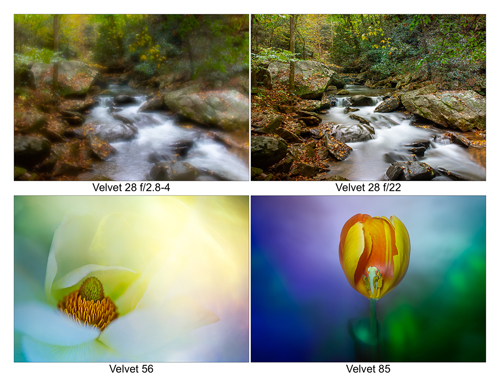 The Sol 45mm or 22mm (for micro 4/3rds cameras) yields fascinating results with its ability to tilt up to 8.5o and its “bokeh blades.” This lens is straightforward with a fixed aperture of f/3.5 and 45mm focal length. It is also extremely light at only a bit over 5 ounces. The blades can be moved in or out and can be rotated to infuse a wavy pattern throughout the image, while leaving the subject untouched.
The Sol 45mm or 22mm (for micro 4/3rds cameras) yields fascinating results with its ability to tilt up to 8.5o and its “bokeh blades.” This lens is straightforward with a fixed aperture of f/3.5 and 45mm focal length. It is also extremely light at only a bit over 5 ounces. The blades can be moved in or out and can be rotated to infuse a wavy pattern throughout the image, while leaving the subject untouched.
Finally, the Velvet series lives up to its name by lending a velvety aura or glow to subjects, similar to the Orton effect. The amount of effect is directly correlated to the aperture; at its peak wide open. The 28mm is optimal for landscapes, but can also focus as close as 2 inches, akin to a wide-angle macro. The 56mm and 85mm have a more constrained focal length, each with increasingly more reach.
The myriad choices offer the floral photographer endless possibilities. Shooting often and becoming familiar with a single lens at a time will give one the experience necessary to make informed lens choices and, thus, be rewarded with unique and beautiful images.
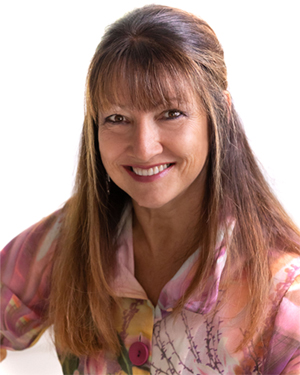 Jackie Kramer is known for her rich use of colors and fresh style in her floral photography. Her images have received international awards and have been published in several magazines. Jackie is a Lensbaby Ambassador & KelbyOne instructor. Jackie maintains an online group called Phlorography with over 7,000 floral photographers from around the world. She leads workshops where learning and fun are the foundation and is committed to enriching others through the medium of photography. She will be teaching a class on “Artistic Floral Photography” at Texas School ‘21. Her floral work can be seen online at www.luvblooms.com. You can learn about her class at www.TexasSchool.org.
Jackie Kramer is known for her rich use of colors and fresh style in her floral photography. Her images have received international awards and have been published in several magazines. Jackie is a Lensbaby Ambassador & KelbyOne instructor. Jackie maintains an online group called Phlorography with over 7,000 floral photographers from around the world. She leads workshops where learning and fun are the foundation and is committed to enriching others through the medium of photography. She will be teaching a class on “Artistic Floral Photography” at Texas School ‘21. Her floral work can be seen online at www.luvblooms.com. You can learn about her class at www.TexasSchool.org.



